Supported Imidazolium-Based Ionic Liquids on a Polysulfone Matrix for Enhanced CO2 Capture
Abstract
1. Introduction
2. Materials and Methods
2.1. Materials
2.2. Ionic Liquids Preparation and Characterization
2.3. Membrane Preparation, Ionic Liquids Supporting Methods, and Characterization
2.4. CO2 Sorption Studies
3. Results
3.1. Synthesized Ionic Liquids
3.2. Physio-Chemical Characterizations of Membranes
3.2.1. Infrared Studies (IR)
3.2.2. Energy Dispersive X-ray Elemental Analysis
3.3. Sorption of the ILs into Membrane Pores by Capillary Forces
3.3.1. Mass Increase Determination
3.3.2. Membrane Roughness Determination
3.3.3. Contact Angle Determination
3.4. Solubility Results
4. Conclusions
Supplementary Materials
Author Contributions
Funding
Institutional Review Board Statement
Informed Consent Statement
Data Availability Statement
Acknowledgments
Conflicts of Interest
References
- Kazemifar, F.A. Review of Technologies for Carbon Capture, Sequestration, and Utilization: Cost, Capacity, and Technology Readiness. Greenh. Gases Sci. Technol. 2022, 12, 200–230. [Google Scholar] [CrossRef]
- Modak, A.; Bhanja, P.; Dutta, S.; Chowdhury, B.; Bhaumik, A. Catalytic Reduction of CO2 into Fuels and Fine Chemicals. Green Chem. 2020, 22, 4002–4033. [Google Scholar] [CrossRef]
- World Resources Institute. Climate Analysis Indicators Tool (CAIT); World Resources Institute: Washington, DC, USA, 2019. [Google Scholar]
- Ghosh, S.; Modak, A.; Samanta, A.; Kole, K.; Jana, S. Recent Progress in Materials Development for CO2 conversion: Issues and Challenges. Mater. Adv. 2021, 2, 3161–3187. [Google Scholar] [CrossRef]
- Zhao, S.; Feron, P.H.M.; Deng, L.; Favre, E.; Chabanon, E.; Yan, S.; Hou, J.; Chen, V.; Qi, H. Status and Progress of Membrane Contactors in Post-Combustion Carbon Capture: A State-of-the-Art Review of New Developments. J. Membr. Sci. 2016, 511, 180–206. [Google Scholar] [CrossRef]
- Blauwhoff, P.M.M.; Versteeg, G.F.; van Swaaij, W.P.M. A Study on the Reaction between CO2 and Alkanolamines in Aqueous Solutions. Chem. Eng. Sci. 1983, 38, 1411–1429. [Google Scholar] [CrossRef]
- Mota-Lima, A.; Alcantara, M.L.; Pérez-Sanz, F.J.; Bazito, R.C.; Vidinha, P.; Alves, R.M.B.; Nascimento, C.A.O. Review—High-Pressure Carbon Dioxide Separation Using Ionic Liquids: A CO2—Electrocatalysis Perspective. J. Electrochem. Soc. 2021, 168, 086502. [Google Scholar] [CrossRef]
- Wasserscheid, P.; Keim, W. Ionic Liquids—New “Solutions” for Transition Metal Catalysis. Angew. Chem. Int. Ed. 2000, 39, 3772–3789. [Google Scholar] [CrossRef]
- Dai, L.; Yu, S.; Shan, Y.; He, M. Novel Room Temperature Inorganic Ionic Liquids. Eur. J. Inorg. Chem. 2004, 2004, 237–241. [Google Scholar] [CrossRef]
- Shobukawa, H.; Tokuda, H.; Susan, M.A.B.H.; Watanabe, M. Ion Transport Properties of Lithium Ionic Liquids and Their Ion Gels. Electrochim. Acta 2005, 50, 3872–3877. [Google Scholar] [CrossRef]
- Simon, N.M.; Zanatta, M.; Neumann, J.; Girard, A.L.; Marin, G.; Stassen, H.; Dupont, J. Cation–Anion–CO2 Interactions in Imidazolium-Based Ionic Liquid Sorbents. ChemPhysChem 2018, 19, 2879–2884. [Google Scholar] [CrossRef]
- De los Ríos, A.P.; Irabien, A.; Hollmann, F.; Fernández, F.J.H. Ionic Liquids: Green Solvents for Chemical Processing. J. Chem. 2013, 2013, 2–4. [Google Scholar] [CrossRef]
- Lei, Z.; Chen, B.; Koo, Y.M.; Macfarlane, D.R. Introduction: Ionic Liquids. Chem. Rev. 2017, 117, 6633–6635. [Google Scholar] [CrossRef] [PubMed]
- Campisciano, V.; Giacalone, F.; Gruttadauria, M. Supported Ionic Liquids: A Versatile and Useful Class of Materials; The Chemical Record; John Wiley and Sons Inc.: New York, NY, USA, 2017; pp. 918–938. [Google Scholar] [CrossRef]
- Wang, H.H.; Jung, J.T.; Kim, J.F.; Kim, S.; Drioli, E.; Lee, Y.M. A Novel Green Solvent Alternative for Polymeric Membrane Preparation via Nonsolvent-Induced Phase Separation (NIPS). J. Membr. Sci. 2019, 574, 44–54. [Google Scholar] [CrossRef]
- Torras, C.; Garcia-Valls, R. Quantification of Membrane Morphology by Interpretation of Scanning Electron Microscopy Images. J. Membr. Sci. 2004, 233, 119–127. [Google Scholar] [CrossRef]
- Nogalska, A. Ambient Carbon Dioxide Capture and Conversion via Membranes. Ph.D. Dissertation, Universitat Rovira i Virgili, Tarragona, Spain, 2018. [Google Scholar]
- Nogalska, A.; Zukowska, A.; Garcia-Valls, R. Atmospheric CO2 Capture for the Artificial Photosynthetic System. Sci. Total Environ. 2018, 621, 186–192. [Google Scholar] [CrossRef] [PubMed]
- Tylkowski, B.; Carosio, F.; Castañeda, J.; Alongi, J.; García-Valls, R.; Malucelli, G.; Giamberini, M. Permeation Behavior of Polysulfone Membranes Modified by Fully Organic Layer-by-Layer Assemblies. Ind. Eng. Chem. Res. 2013, 52, 16406–16413. [Google Scholar] [CrossRef]
- Gomez-Coma, L.; Garea, A.; Irabien, A. Carbon Dioxide Capture by [Emim][Ac] Ionic Liquid in a Polysulfone Hollow Fiber Membrane Contactor. Int. J. Greenh. Gas Control 2016, 52, 401–409. [Google Scholar] [CrossRef]
- Ramos, V.C.; Han, W.; Zhang, X.; Zhang, S.; Yeung, K.L. Supported Ionic Liquids for Air Purification. Curr. Opin. Green Sustain. Chem. 2020, 25, 100391. [Google Scholar] [CrossRef]
- Patil, T.; Dharaskar, S.; Sinha, M.; Jampa, S.S. Effectiveness of Ionic Liquid-Supported Membranes for Carbon Dioxide Capture: A Review. Environ. Sci. Pollut. Res. 2022, 29, 35723–35745. [Google Scholar] [CrossRef]
- Dupont, J.; Consorti, C.S.; Suarez, P.A.Z.; Souza, R.F. Preparation of 1-Butyl-3-Methyl Imidazolium-Based Room Temperature Ionic Liquids. Org. Synth. 2003, 79, 236. [Google Scholar] [CrossRef]
- Horcas, I.; Fernández, R.; Gómez-Rodríguez, J.M.; Colchero, J.; Gómez-Herrero, J.; Baro, A.M. WSXM: A Software for Scanning Probe Microscopy and a Tool for Nanotechnology. Rev. Sci. Instrum. 2007, 78, 013705. [Google Scholar] [CrossRef] [PubMed]
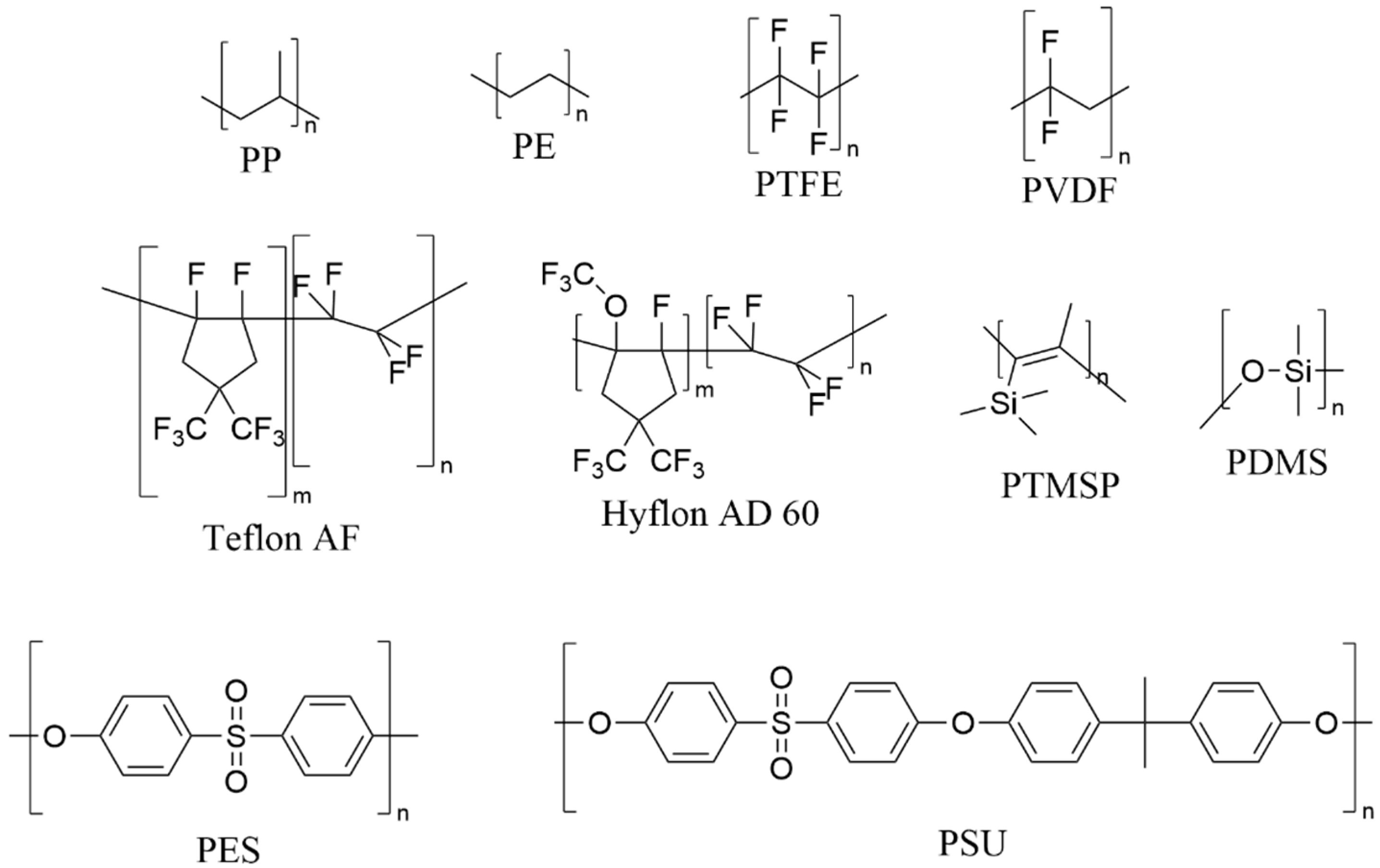
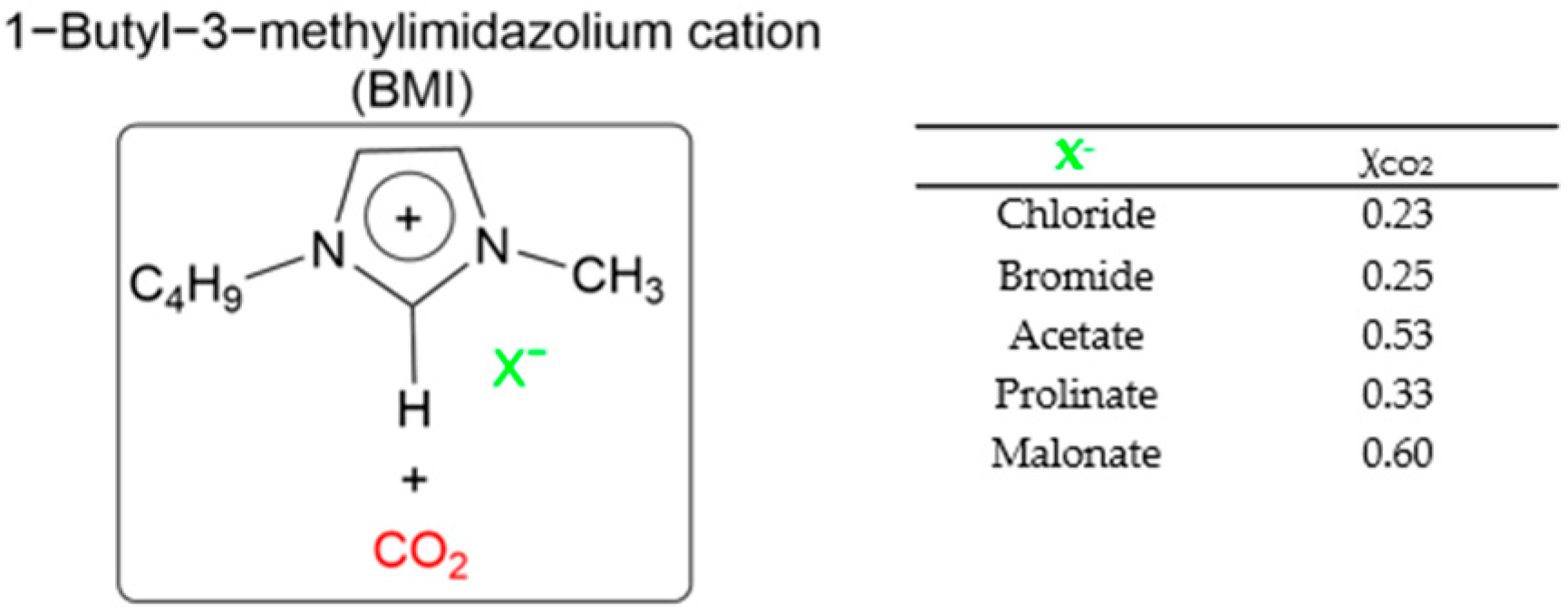
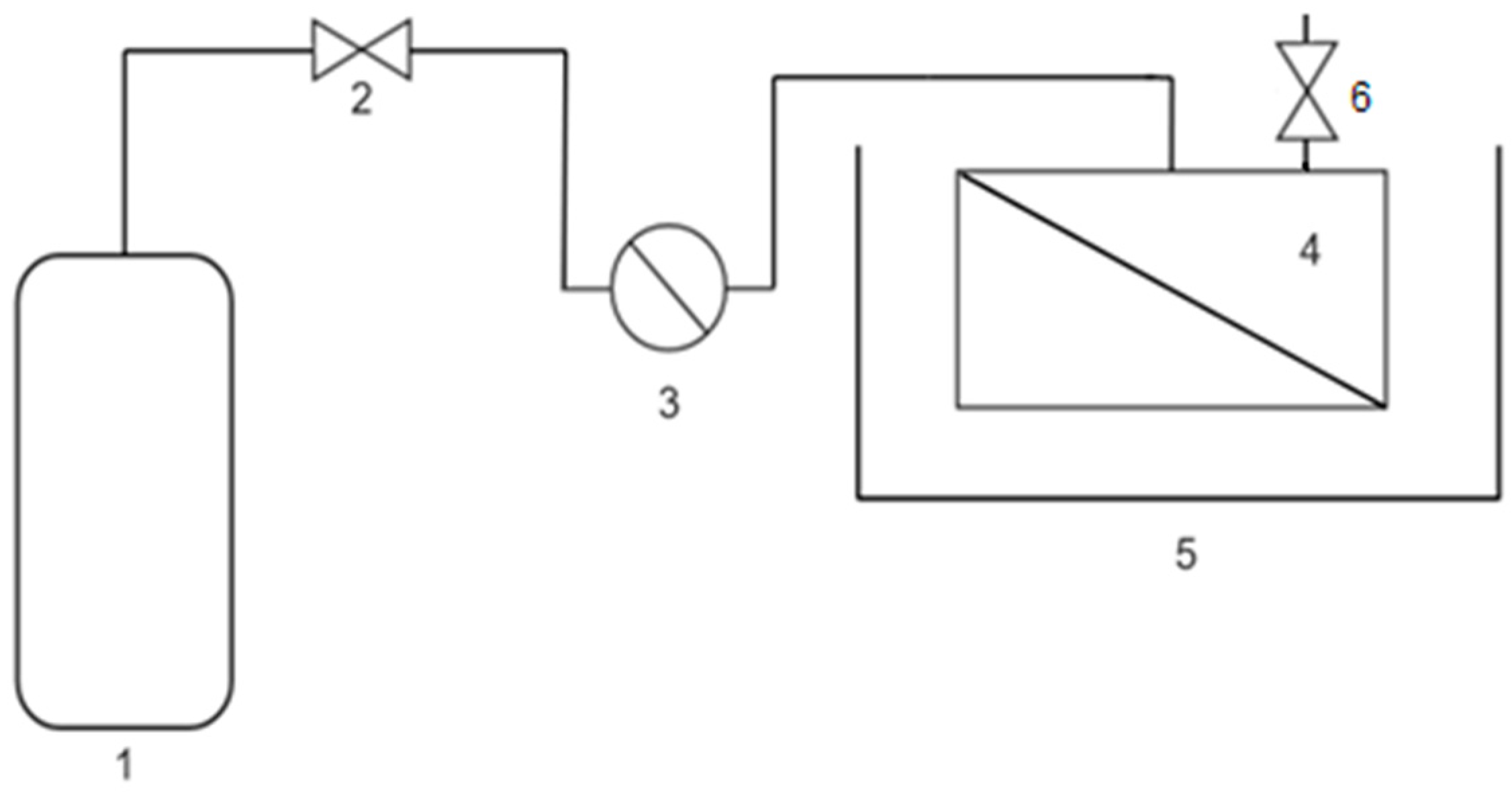




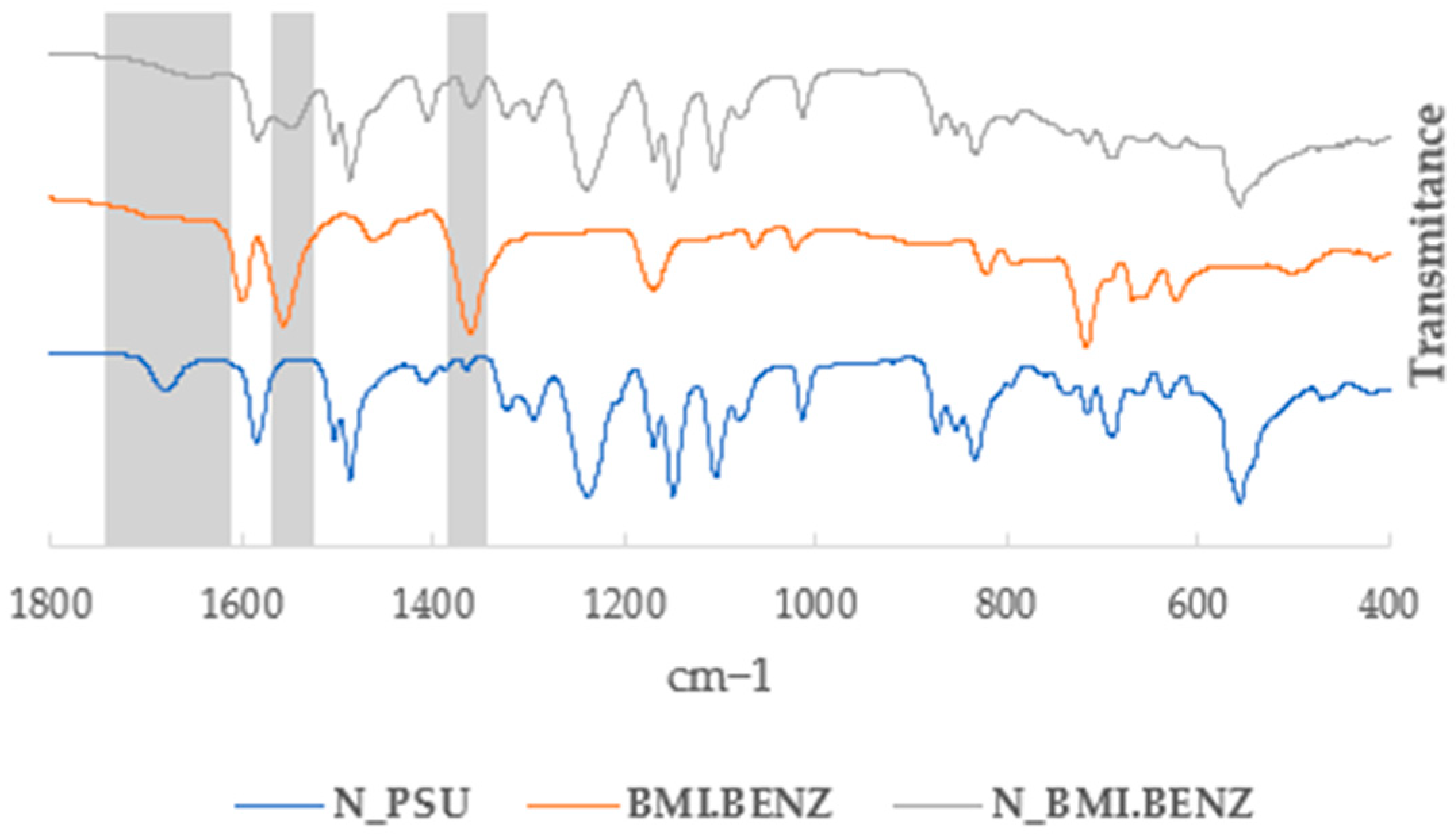

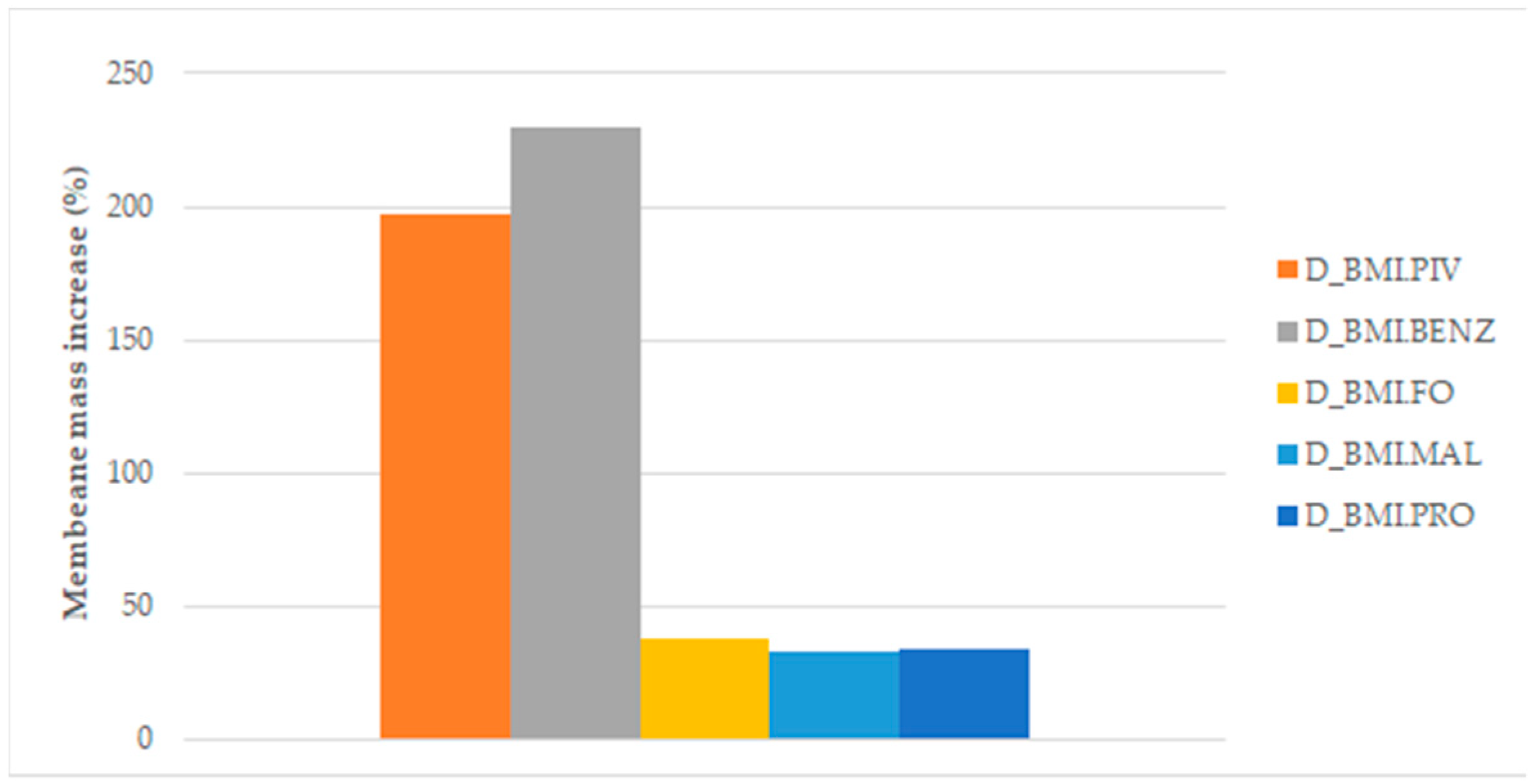
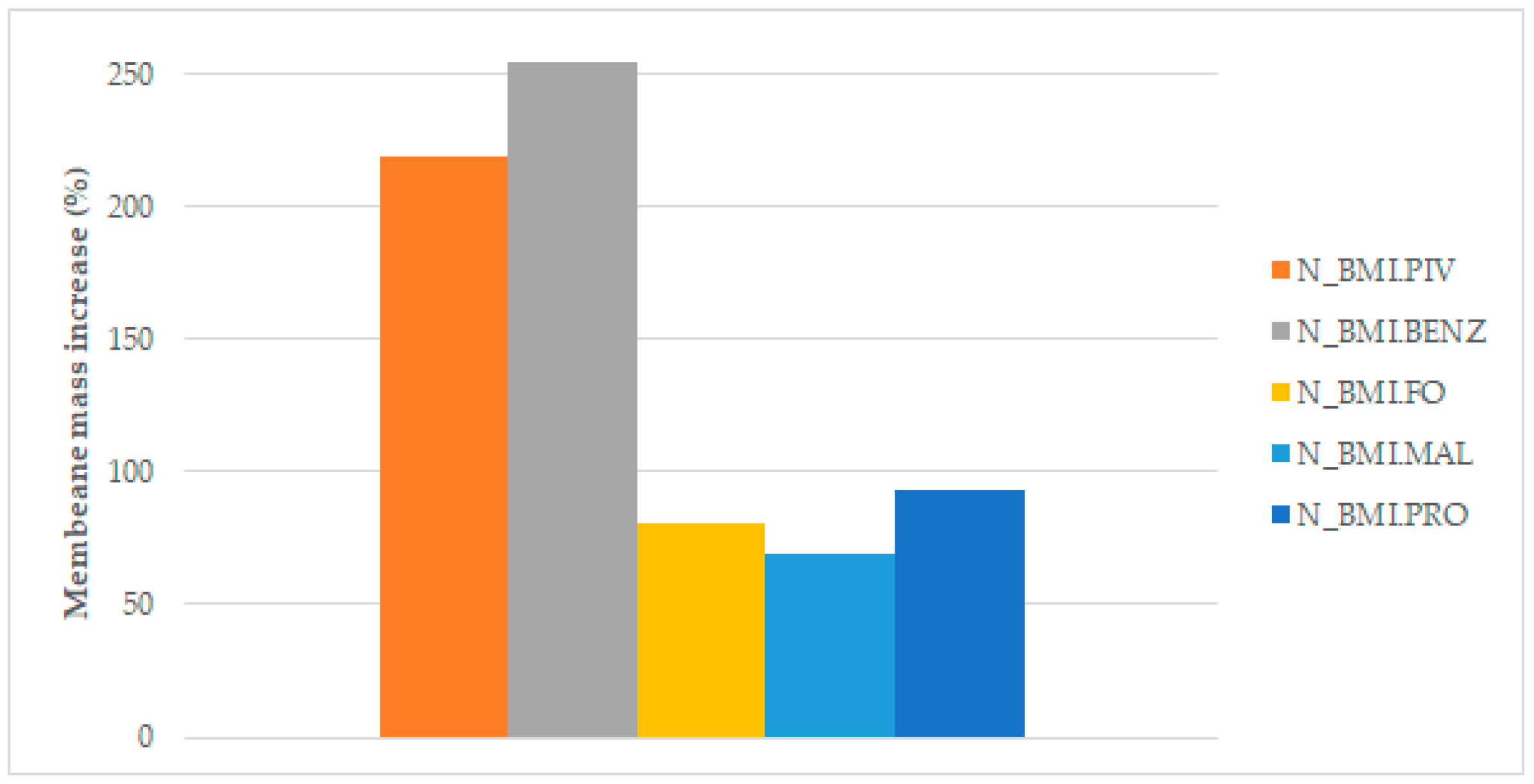
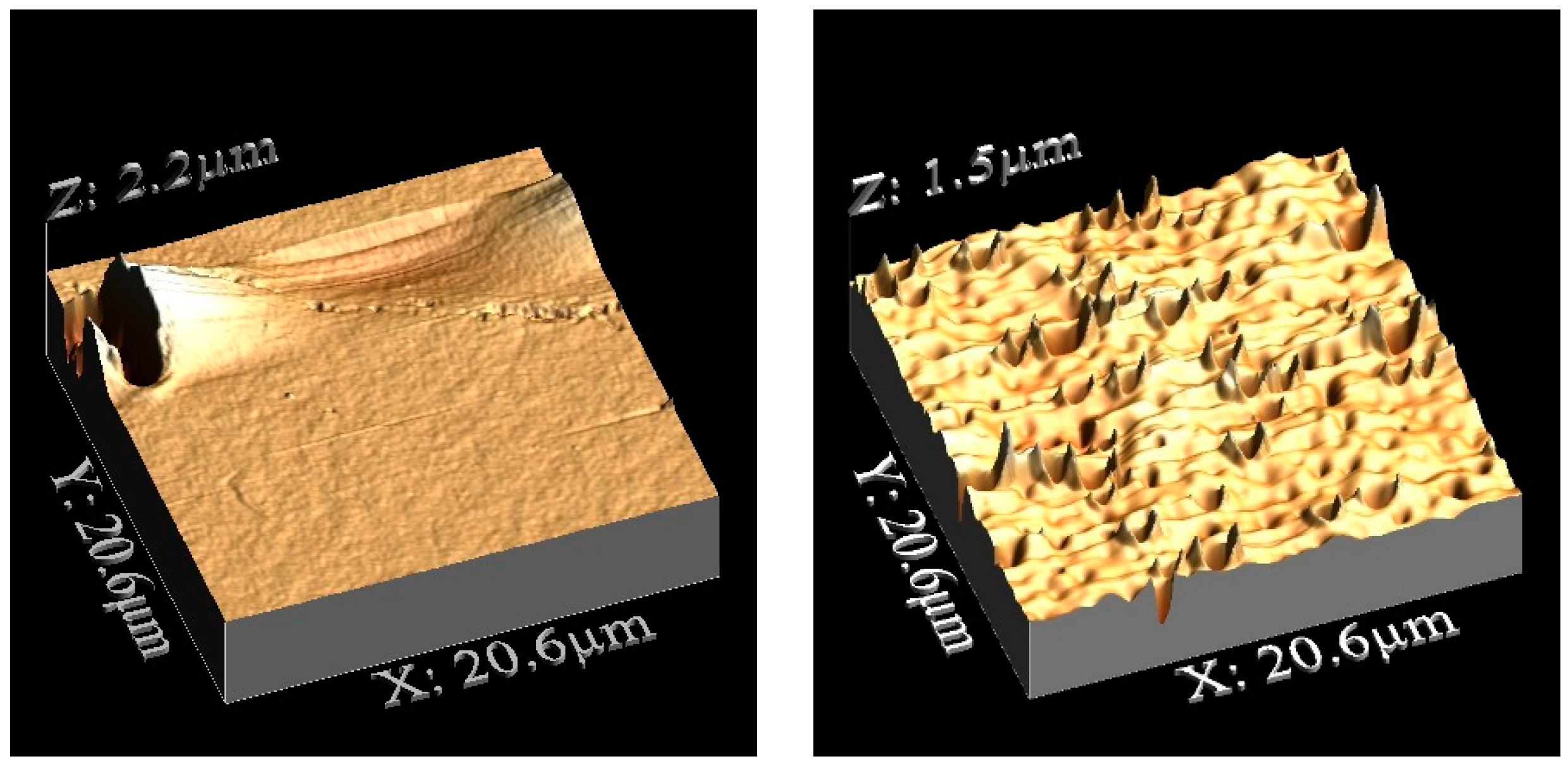
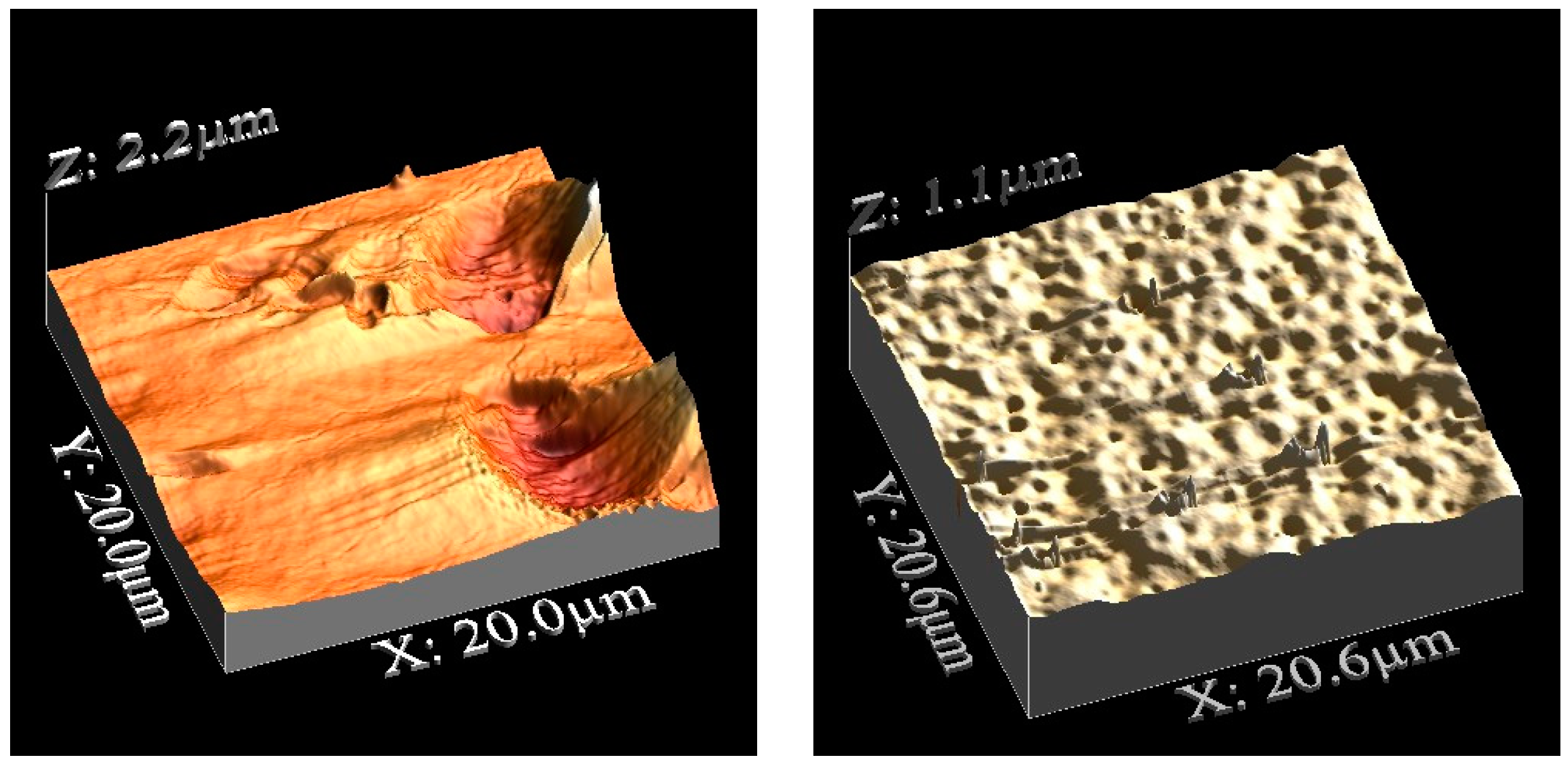


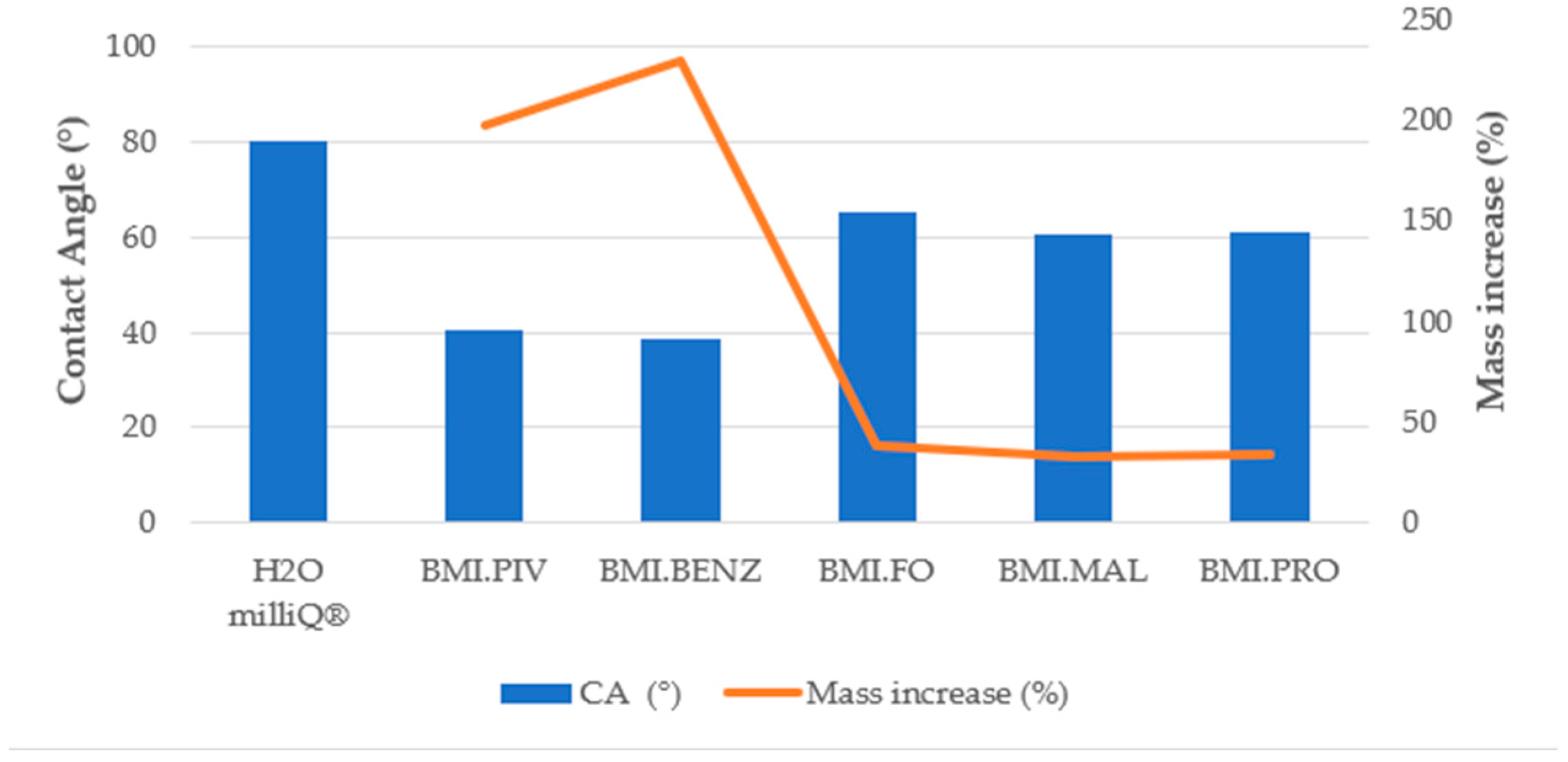
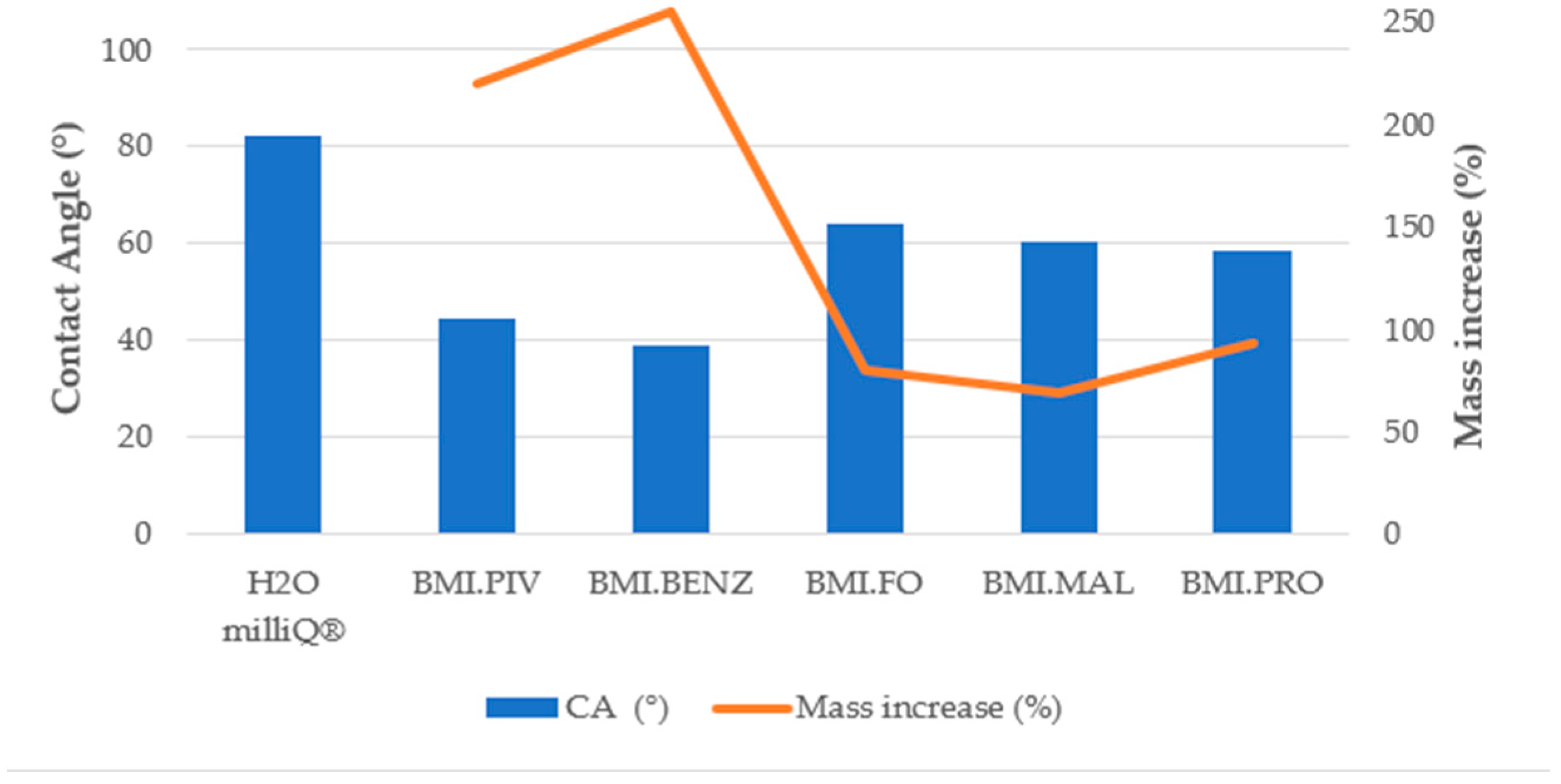
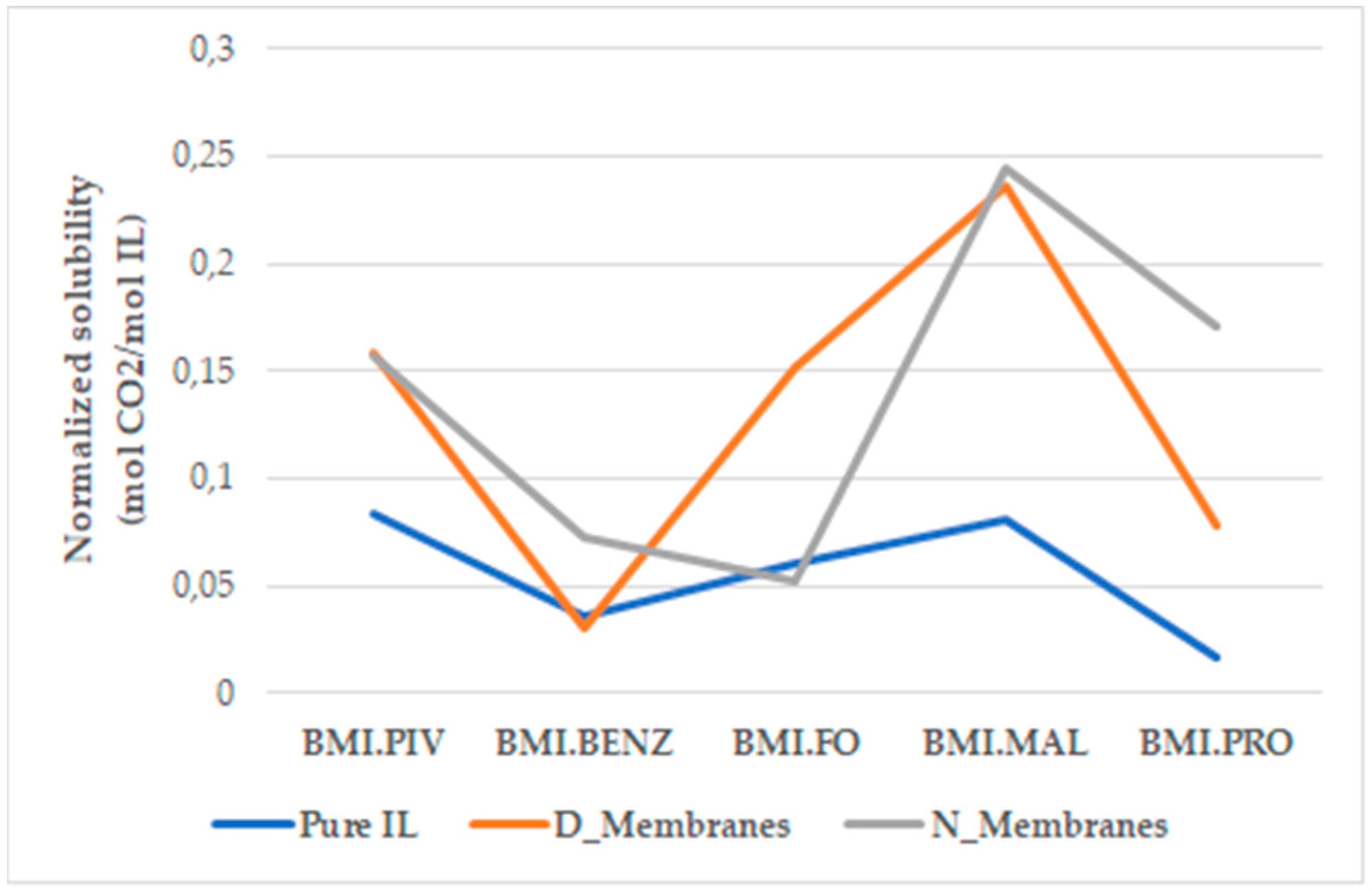
| Type | Ionic Liquid | Carboxylic Acid Used | Ionic Liquid Structure |
|---|---|---|---|
| 1 | BMI.PIV | Pivalic Acid (PIV) | 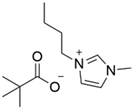 |
| 1 | BMI.BENZ | Benzoic Acid (BENZ) |  |
| 1 | BMI.FO | Formic Acid (FO) |  |
| 2 | BMI.MAL | Malonic Acid (MAL) | 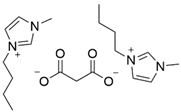 |
| 3 | BMI.PRO | Proline (PRO) |  |
| Classification | Sample | Solvent | Ionic Liquid Cation | Ionic Liquid Anion |
|---|---|---|---|---|
| D_Membranes | D_PSU | DMF | - | - |
| D_BMI.PIV | BMI | Pivalate | ||
| D_BMI.BENZ | BMI | Benzoate | ||
| D_BMI.FO | BMI | Formate | ||
| D_BMI.MAL | 2 BMI | Malonate | ||
| D_BMI.PRO | BMI | Prolinate | ||
| N_Membranes | N_PSU | NMP | - | - |
| N_BMI.PIV | BMI | Pivalate | ||
| N_BMI.BENZ | BMI | Benzoate | ||
| N_BMI.FO | BMI | Formate | ||
| N_BMI.MAL | 2 BMI | Malonate | ||
| N_BMI.PRO | BMI | Prolinate |
| D_Blank | N_Blank | |
|---|---|---|
| Process | Immersion precipitation | |
| Polymeric Solution | 20% w/w of polysulfone | |
| Solvent | DMF | NMP |
| Casting Knife (μm) | 200 | |
| Support | Glass | |
| Membrane Thickness (μm) | 94.1 ± 0.2 | 129.6 ± 0.3 |
| Porosity (%) | 67 | 73 |
| Macrovoid size (μm) | 32 ± 7 | 15 ± 4 |
| Membrane | Surface | Average Roughness (Ra) | Root Mean Square (Rq) | Skewness |
|---|---|---|---|---|
| D_ PSU | Top | 0.05 ± 0.6 | 0.13 ± 0.08 | −0.84 |
| D_ PSU | Bottom | 0.0654 ± 0.007 | 0.106 ± 0.004 | −2.29 |
| N_ PSU | Top | 0.16 ± 0.04 | 0.21 ± 0.02 | 0.27 |
| N_ PSU | Bottom | 0.027 ± 0.005 | 0.041 ± 0.002 | −3.69 |
| Membrane | Solubility Coefficient (S) (m3(STP) m−3membrane atm−1) |
|---|---|
| D_PSU | 4.16 × 104 |
| D_BMI.PIV | 5.25 × 106 |
| D_BMI.BENZ | 2.72 × 106 |
| D_BMI.FO | 2.03 × 105 |
| D_BMI.MAL | 1.31 × 105 |
| D_BMI.PRO | 7.27 × 104 |
| N_PSU | 1.83 × 105 |
| N_BMI.PIV | 7.30 × 1011 |
| N_BMI.BENZ | 3.40 × 1011 |
| N_BMI.FO | 5.08 × 105 |
| N_BMI.MAL | 1.05 × 106 |
| N_BMI.PRO | 2.52 × 106 |
Publisher’s Note: MDPI stays neutral with regard to jurisdictional claims in published maps and institutional affiliations. |
© 2022 by the authors. Licensee MDPI, Basel, Switzerland. This article is an open access article distributed under the terms and conditions of the Creative Commons Attribution (CC BY) license (https://creativecommons.org/licenses/by/4.0/).
Share and Cite
Domingo Huguet, D.; Gual, A.; Garcia-Valls, R.; Nogalska, A. Supported Imidazolium-Based Ionic Liquids on a Polysulfone Matrix for Enhanced CO2 Capture. Polymers 2022, 14, 4865. https://doi.org/10.3390/polym14224865
Domingo Huguet D, Gual A, Garcia-Valls R, Nogalska A. Supported Imidazolium-Based Ionic Liquids on a Polysulfone Matrix for Enhanced CO2 Capture. Polymers. 2022; 14(22):4865. https://doi.org/10.3390/polym14224865
Chicago/Turabian StyleDomingo Huguet, David, Aitor Gual, Ricard Garcia-Valls, and Adrianna Nogalska. 2022. "Supported Imidazolium-Based Ionic Liquids on a Polysulfone Matrix for Enhanced CO2 Capture" Polymers 14, no. 22: 4865. https://doi.org/10.3390/polym14224865
APA StyleDomingo Huguet, D., Gual, A., Garcia-Valls, R., & Nogalska, A. (2022). Supported Imidazolium-Based Ionic Liquids on a Polysulfone Matrix for Enhanced CO2 Capture. Polymers, 14(22), 4865. https://doi.org/10.3390/polym14224865







